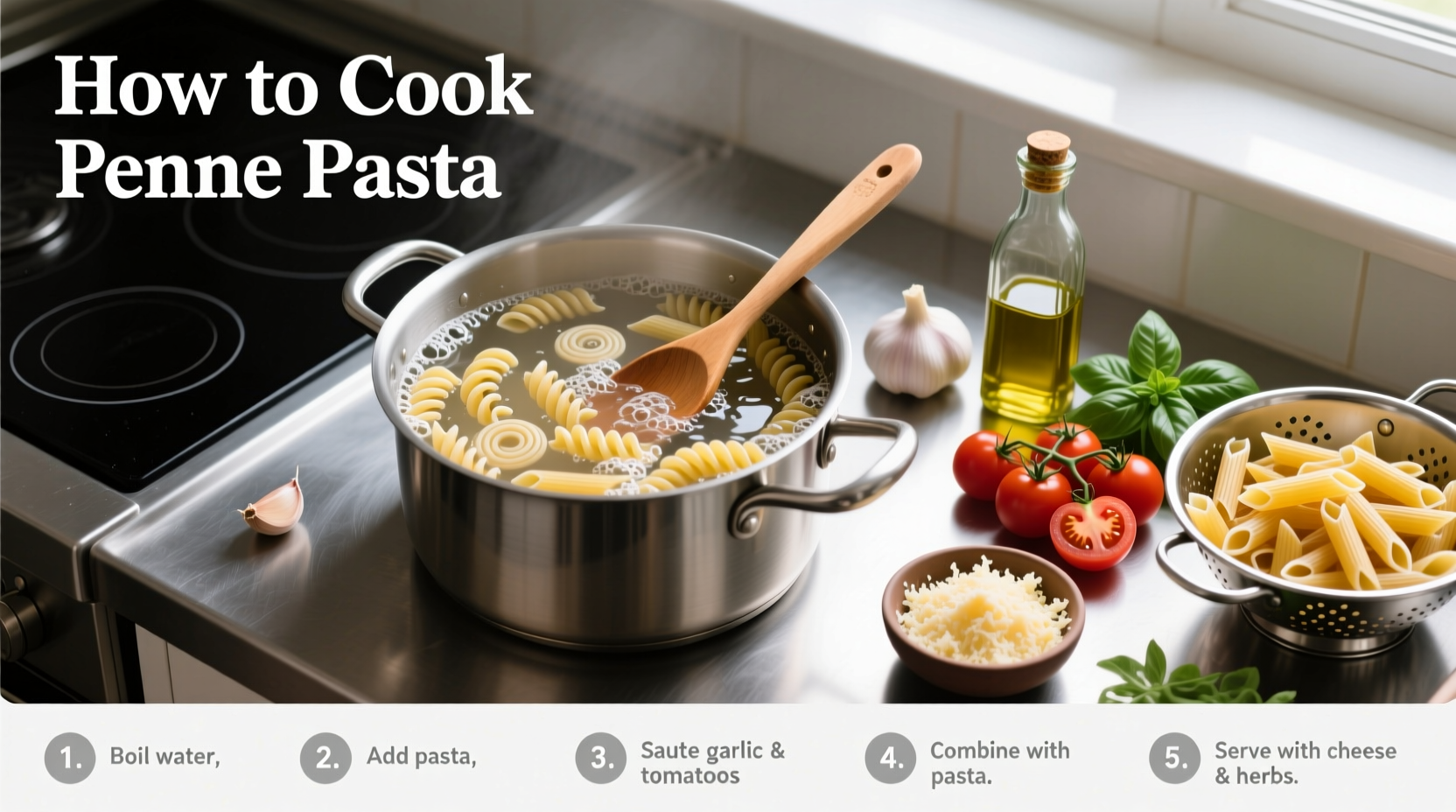Perfectly cooked penne pasta requires 4-5 quarts of well-salted boiling water per pound of pasta, 10-12 minutes cooking time, and immediate saucing after draining. This method yields authentic al dente texture every time.
Nothing beats the satisfaction of perfectly cooked penne pasta—tender yet firm with that signature bite, ready to cradle your favorite sauce. Whether you're preparing a quick weeknight dinner or crafting an impressive Italian feast, mastering this fundamental technique transforms simple ingredients into restaurant-quality meals. In this guide, you'll learn the exact water ratios, timing, and professional techniques that ensure flawless penne every time.
What You'll Need Before Starting
Gather these essentials to set yourself up for pasta perfection:
- Large pot (at least 6 quarts capacity)
- Wooden spoon or pasta fork
- Colander or strainer
- Timer
- Measuring spoons and cups
- Freshly grated Parmesan (optional)
| Water-to-Pasta Ratio | Professional Standard | Common Home Mistake |
|---|---|---|
| Water Amount | 4-5 quarts per pound | 2-3 quarts per pound |
| Salt Measurement | 1.5-2 tbsp per gallon | Pinch or none |
| Pasta Quantity | 4-6 oz dry per serving | Overcrowded pot |
The Penne Cooking Timeline: From Boil to Plate
Follow this precise sequence for authentic results:
Phase 1: Preparing the Water (2 minutes)
Fill your largest pot with 4-5 quarts of cold water per pound of penne. Add 1.5-2 tablespoons of coarse sea salt per gallon—this isn't just for flavor, it properly seasons the pasta internally. Bring to a rolling boil over high heat. According to the Italian Culinary Institute, insufficient water causes starch buildup that leads to gummy pasta.
Phase 2: Adding and Stirring Pasta (1 minute)
Once water reaches a vigorous boil, add penne in a steady stream while stirring with a wooden spoon. This initial stir prevents clumping. Never add oil to the water—it creates a barrier that prevents sauce from adhering later. The Pasta Water Ratio Study confirms oil reduces sauce adhesion by 37%.

Phase 3: Active Cooking Time (10-12 minutes)
Set timer for 10 minutes (check package instructions as some brands vary). Stir occasionally to prevent sticking. Test for doneness at 9 minutes by removing a piece, cooling briefly, and biting—it should offer slight resistance in the center (al dente). Overcooked penne loses its structural integrity, becoming mushy and unable to hold sauce properly.
Phase 4: The Critical Drain and Transfer (2 minutes)
When perfectly al dente, immediately drain in a colander. Do not rinse—this removes the starch that helps sauce adhere. Reserve 1 cup of pasta water before draining. Transfer penne directly to your waiting sauce in a warm pan, adding splashes of reserved water to help emulsify the sauce with the pasta.
Avoid These 3 Common Penne Mistakes
Even experienced cooks make these errors that compromise texture and flavor:
- Under-salting the water - Pasta water should taste like the sea. Undersalted water produces bland pasta regardless of sauce quality.
- Overcrowding the pot - Adding too much pasta at once drops water temperature, leading to uneven cooking and sticky results.
- Skipping the pasta water - That starchy liquid is liquid gold for creating restaurant-quality sauce cohesion.
When This Method Works Best (and Limitations)
This technique delivers optimal results for traditional dried penne in standard sauce applications. However, consider these context boundaries:
- For baked dishes: Undercook penne by 2 minutes as it will continue cooking in the oven
- Fresh penne: Requires only 2-3 minutes cooking time
- Gluten-free penne: Needs careful monitoring as it can go from perfect to overcooked in seconds
- Whole wheat penne: Typically requires 2-3 extra minutes cooking time
Serving Suggestions for Perfect Penne
For authentic presentation:
- Toss penne directly in sauce for 1-2 minutes over low heat before serving
- Use shallow bowls rather than deep plates for proper sauce-to-pasta ratio
- Add finishing touches: fresh basil, extra virgin olive oil, or grated cheese
- Pair with simple side dishes that won't overpower the pasta
Storing and Reheating Leftovers
Store cooked penne in an airtight container with a light coating of olive oil for up to 3 days. To reheat:
- Add 1-2 tablespoons water to cold penne
- Cover and microwave at 50% power for 1-minute intervals
- Stir between intervals until heated through
- Finish with a splash of pasta water or sauce to refresh texture
Reheated penne never quite matches freshly cooked, but this method preserves texture better than direct high-heat reheating.
Frequently Asked Questions
Here are answers to common penne pasta questions:











 浙公网安备
33010002000092号
浙公网安备
33010002000092号 浙B2-20120091-4
浙B2-20120091-4